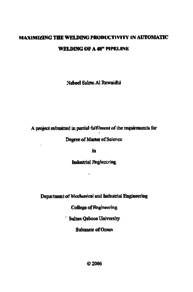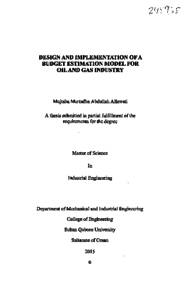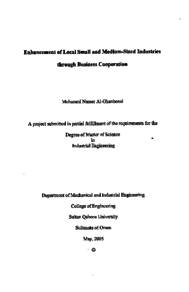وثيقة
Maximizing the welding Productivity in Automatic Welding of a 48" Pipeline
الناشر
Sultan Qaboos University
ميلادي
2006
اللغة
الأنجليزية
الموضوع
الملخص الإنجليزي
Installation of new pipelines is predicted to grow at a rapid rate over the next twenty years, due in part to the increased use worldwide of combined cycle power generation plants using natural gas. The need to construct large diameter pipelines over long distances has led to an increased demand to improve the productivity of pipeline girth welding. Worldwide, it is reported that 20,000 km of pipelines were completed in 2003 at a cost of US$ 15 billion and 41,000km were planned for in 2004 (Yapp and Blackman, 2004).
Both contractors and major operators strive to increase the productivity of their pipeline projects. This leads to project being completed sooner giving potential benefits to the operator and contractor. The former sees income sooner and the latter has reduced overheads.
The objective of this project was to explore and provide means to improve the productivity of automatic welding of pipelines. A field study focused on the current automatic welding practices in a major 48" pipeline project undertaken by Petroleum Development Oman in 2004 and 2005. The aim was to increase the welding production rate per day by exploring potential improvement areas and applying the principles of productivity improvement techniques to these areas.
The Field survey on the 48" pipeline project revealed a number of areas that required attention. They include a review of the current welding preheating task, a review of the means to reduce delay time during welding interruption and review of the welding station sequencing and numbers.
The study adopted a revised preheating technique and initiated improvements on welders' skills to minimize welding interruption. It initiated a modeling tool for computing the optimum number of welding stations and their best sequence.
The study concluded that a 3% improvement could be achieved on joint welding time by adopting the revised preheating technique proposed and a 12% improvement by eliminating unnecessary grinding.
Combining the improvement on preheating and grinding elimination with the results of modeling for the optimum number of welding stations an increase of 65% in production rate is possible. This could result in a 14% saving in welding costs for the contractor and in the project's earlier completion thus benefiting the pipeline operator.
This study could assist in faster completion of pipeline projects thus earlier earnings to pipeline operators, and possibly reduce the overheads of the contractor due to reduced project duration.
المجموعة
URL المصدر
الملخص العربي
إن قطاع الإنشاءات لخطوط الأنابيب يتوقع له أن ينمو بخطى متسارعة خلال العشرين سنة القادمة نتيجة التزايد طلب محطات توليد الطاقة للغاز الطبيعي وبالتالي تزايدت الحاجة لإنشاء خطوط النقل ذات السعات العالية والمسافات الطويلة. وكان لا بد من تحسين إنتاجية مد الخطوط لمواكبة هذا النمو. حيث تفيد التقارير باکمال عشرين ألف كيلومتر من خطوط الأنابيب في عام 2003 على مستوى العالم بتكلفة وقدرها خمسة عشر مليار دولار أمريكي وخطط لانشاء واحد وأربعين ألف كيلومتر في عام 2004.
يعمل المقاولون والمالكون لشبكات النقل بشغف لتطوير الإنتاجية بمشاريعهم وتحسين سرعة الإنتاج ورفع عوائد استثماراتهم. حيث أن المالكين يستفيدون من البيع المبكر لصادراتهم بينما يستفيد المقاولون من خفض التكلفة.
أهداف هذه الدراسة تنصب في إستكشاف وإستنتاج أساليب محسنة لتطوير الإنتاجية في عمليات اللحام الآلي لوصلات الأنابيب. وهي دراسة ميدانية إستهدفت مشروع إنشاء خط الغاز الحكومي 48 بوصة المشرفة عليه شركة تنمية نفط عمان في الفترة من 2004 وحتى 2005. وقد ركزت الدراسة على رفع معدل لحام الوصلات اليومي بتطبيق مبادئ وتقنيات تحسين الإنتاجية الصناعية.
البحث الميداني في المشروع المستهدف ساعد على التعرف على عدة محاور تتطلب لفت النظر اليها وهي: أولا الحاجة إلى مراجعة عملية التسخين الحراري ما قبل اللحام. ثانيا الحاجة للاقتصاد في الوقت اثناء عملية اللحام. وثالثا الحاجة للتوصل إلى العدد والترتيب الأمثل لإجهزة اللحام الآلي المختلفة.
لقد توصلت الدراسة إلى إمكانية تحسين وقت اللحام للوصلة الواحدة بنسبة 3% بتبني الطرق المحسنة المقترحة للتسخين الحراري ما قبل اللحام. وأيضا تحسين الوقت بنسبة 12% بالتقليل من الخطوات غير المجدية في اثناء اللحام وبالتالي تقليل الوقت الفاقد
كما توصلت الدراسة بأن تبني العدد والترتيب الأمثل المستنتج من الدراسة للتشكيلات المختلفة من آليات اللحام يمكن أن يحسن من الانتاج اليومي بنسبة 65%. هذا بالتالي سينتج وافر مالي للمقاول في تكلفة عمليات اللحام للوصلات بنسبة 14% و إنجاز مبكر للمشروع بالنسبة للمالك.
يتأمل من الدراسة أن تساهم في تحسين سرعة إنجاز المشاريع المستقبلية لخطوط الأنابيب مما يعود على المالكين بفوائد استثمارية مبكرة وستقلل من تكاليف إنشاء هذه المشاريع.
يعمل المقاولون والمالكون لشبكات النقل بشغف لتطوير الإنتاجية بمشاريعهم وتحسين سرعة الإنتاج ورفع عوائد استثماراتهم. حيث أن المالكين يستفيدون من البيع المبكر لصادراتهم بينما يستفيد المقاولون من خفض التكلفة.
أهداف هذه الدراسة تنصب في إستكشاف وإستنتاج أساليب محسنة لتطوير الإنتاجية في عمليات اللحام الآلي لوصلات الأنابيب. وهي دراسة ميدانية إستهدفت مشروع إنشاء خط الغاز الحكومي 48 بوصة المشرفة عليه شركة تنمية نفط عمان في الفترة من 2004 وحتى 2005. وقد ركزت الدراسة على رفع معدل لحام الوصلات اليومي بتطبيق مبادئ وتقنيات تحسين الإنتاجية الصناعية.
البحث الميداني في المشروع المستهدف ساعد على التعرف على عدة محاور تتطلب لفت النظر اليها وهي: أولا الحاجة إلى مراجعة عملية التسخين الحراري ما قبل اللحام. ثانيا الحاجة للاقتصاد في الوقت اثناء عملية اللحام. وثالثا الحاجة للتوصل إلى العدد والترتيب الأمثل لإجهزة اللحام الآلي المختلفة.
لقد توصلت الدراسة إلى إمكانية تحسين وقت اللحام للوصلة الواحدة بنسبة 3% بتبني الطرق المحسنة المقترحة للتسخين الحراري ما قبل اللحام. وأيضا تحسين الوقت بنسبة 12% بالتقليل من الخطوات غير المجدية في اثناء اللحام وبالتالي تقليل الوقت الفاقد
كما توصلت الدراسة بأن تبني العدد والترتيب الأمثل المستنتج من الدراسة للتشكيلات المختلفة من آليات اللحام يمكن أن يحسن من الانتاج اليومي بنسبة 65%. هذا بالتالي سينتج وافر مالي للمقاول في تكلفة عمليات اللحام للوصلات بنسبة 14% و إنجاز مبكر للمشروع بالنسبة للمالك.
يتأمل من الدراسة أن تساهم في تحسين سرعة إنجاز المشاريع المستقبلية لخطوط الأنابيب مما يعود على المالكين بفوائد استثمارية مبكرة وستقلل من تكاليف إنشاء هذه المشاريع.
قالب العنصر
الرسائل والأطروحات الجامعية



